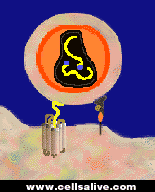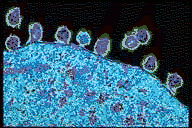

|
HIV Life Cycle |
|
This web page was produced as an assignment for an undergraduate course at Davidson College |
| HIV Entry |
 |
 |
Entry of HIV begins with the envelope protein gp120 binding with high affinity to CD4. A G protein coupled coreceptor of the chemokine family, typically CCR5, must also bind to allow HIV entry. Recent research in the field of cytokines has revealed several major ligands for CCR5. These coreceptor ligand are member of the beta-chemokine family and include RANTES, MIP-1alpha, and MIP-1beta (Janeway et al., 1999) Subsequently, gp41 will fuse the viral envelope and cell membrane to allow the viral RNA to enter the host cell (Schwartz and Nair, 1999). |
| Figure 5- The image on the left shows gp120 binding to CD4 and the chemokine coreceptor ligand binding to CCR5. The animation on the right shows the overall process of viral fusion and entry into a health cell. Used with permission of <www.cellsalive.com>. |
| Reverse Tanscription and Integration |
| The viral RNA undergoes reverse transcription into double stranded cDNA. The DNA then migrates to the nucleus of the host cell where it is integrated into the cell genome and becomes a provirus (Janeway et al. 1999). | Figure 7- A animation of viral cDNA entering into the host genome. Used with permission of <www.cellsalive.com>. | |
| Figure 6- This animation demonstrates the process of transcribing HIV RNA into cDNA for insertion into the host genome. <www.cellsalive.com>. |  |
| Transcription |
 |
The provirus produces mRNA upon activation by using the host cells' transcription factors (Schwartz et al., 1999). Transcription is controlled and activated by the HIV tat gene as well as tumor necrosis factor alpha (TNF-alpha) and interleukin 6 (IL-6) which are secreted in elevated level of HIV infected cells (<www.aegis.com/topic/basics/hivandaids.html>) |
| Figure 8- A simple animation of transcription whereby HIV uses the host cells machinery to produce viral mRNA. Used with permission of <www.cellsalive.com>. |
| Translation |
| The mRNA of the HIV virion is then transported from the nucleus of the host cell to the cytoplasm where structural HIV proteins are made (<www.aegis.com/topic/basics/ hivandaids.html>). This process is controlled by the rev gene as noted in Figure 4 (Janeway et al., 1999). |
| Assembly and Budding |
 |
The structural proteins synthesized from translation begin to take form of the HIV virus. After the envelope of the virus aggregates and the virion "pinches off" from the host cell. In this process of budding host cell membrane is taken up by the virus as part of the fatty envelope. It is important to note that immediately after budding the HIV viral core is immature and not infectious. After budding the HIV protease cleaves the long viral core polypeptide chains to form a functional and infectious molecule (<www.aegis.com/topic/basics/ hivandaids.html>). |
| Figure 9- A scanning electron microscope image of HIV daughter cells budding from an infected host cell. Used wither permission of <http://www.cmsp.com/datav1/cg010001.htm>. |
| Home Page | Introduction | HIV Background and Structure |
| CD4 T Cells Role in HIV Infection | Treatment | References |
|
This web site was created for an Immunology class. Please direct correspondence to jodickens@davidson.edu. Last Updated April 21, 2000 |
|